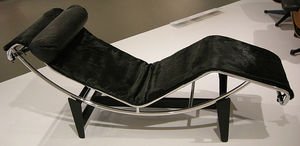There are many types of modern pieces of furniture and many types of modern design categories, but the best pieces are the vintage modern furniture. A oxymoron, combining vintage with modern, but considering that the modern design movement began in the early 1900s, it is what it is.
During the early 1900s, new technologies, the affect of World War I, the emergence of communism and fascism, and new problems of population growth and increase of urban poverty, began a new artistic movement to create new forms and designs, known as the “modern movement”1.
The “modern movement” had four pioneers, who were not only architects, but also artist, interior designers, and furniture designers. These entrepreneurs of this great fore-sight was Europeans Walter Gropius, Ludwig Mies van der Rohe, and Le Corbusier, finally American Frank Lloyd Wright2. Below are examples of famous pieces of furniture by these grandfathers of modern design, which you may like to use as inspiration to incorporate in your design concept.
Frank Lloyd Wright, Dining Room table and chairs at Robie House, 1908-10
The Robie House in Chicago was designed by Frank Lloyd Wright during his early commissions, but is a good example of the early use of the “modern movement”3. The dining room is the most known and admired, with the design of the high-back chairs around the table and the corner lights are meant to create a sense of containment to family and visitors as they sit at the table.
De Stijl Movement – Gerrit Rietveld, Red-Blue chair, 1917.
The De Stijl (The Style) movement, inspired by Frank Lloyd Wright (or “imitated his ideas”, as argued by Frank Lloyd Wright) was primarily concerned with concepts of pure abstraction that surfaced from cubist art at the time4. The most famous example of the De Stijl design used in architecture and interior design is the Schroder House designed by Gerrit Rietveld in 19345. The Red-Blue chair, used in the Schroder house design concept, encompasses the De Stijl movement, in its simplicity and abstract inspiration.
Marcel Breuer, Cesca chair, 1928 and Wassily chair, 1925.
Marcel Breuer was a student of the Baushaus school of design in Germany founded by Walter Gropius6. The Baushaus was classified as being in the International Style in 1932 by critics and historians, because it was a style that was reflected in all nations and countries7. Two well-known classic pieces of furniture from the Baushaus program were designed by Mercel Breuer, who was first a student then an instructor. The Cesca Chair and Wassily Chair, which uses tubular frames along with simple seating solutions of cushions, cane, or stretched leather, create a unique design that was functional and simple. These chairs are still popular and so liked, that manufacturers still produce them today.
Ludwig Mies van der Rohe, Barcelona chair, 1929.
Ludwig Mies van der Rohe, used an open design concept when creating his architecture and interior spaces. Along with the use of steel, glass, and marble; he helped create a modern design that emphasized this abstract arrangement of space, with color and textures of the materials replacing ornamentation. Simple, sleek, and elegant was his style, which is seen in his famous Barcelona chair. The simple steel frame support leather straps, which in turn supports the seat and back cushions covered with tufted leather. Another classic that continues to be manufactured and widely used today.
Le Corbusier and Charlotte Perriand, Chaise, 1929.
Le Corbusier was the founder of the Machine Aesthetic movement, where the beauty of modern machinery is cited as the true artistic expression of the modern world. “A house is a machine for living” a quote he used frequently, which brought different opinions of his aesthetic values8. Le Corbusier used the same concept when designing furniture, such as the chaise. Le Corbusier and co-designer, Charlotte Perriand, produced a modern twist to the traditional chaise by adding an upper structure that slides on the base to allow the seating surface to be placed at variable angles to suit the comfort of the user. A wonderful classic piece of modern furniture, that revolutionized seating to this day.
Modern design has evolved since the early 1900’s when these entrepreneurs thrived and created original and unthought-of concepts and designs. But, in the end, these pieces are the foundation of the modern movement, and always should be considered, if not studied, when designing your next modern inspired project.
Sources:
1 Pile, John. A History of Interior Design. 2nd ed. (New Jersey: John Wiley & Sons, Inc., 2005). 323.
2 Pile 323.
3 Pile 324.
4 Pile 326.
5 Pile 326.
6 Pile 330.
7 Pile 330.
8 Pile 336.








